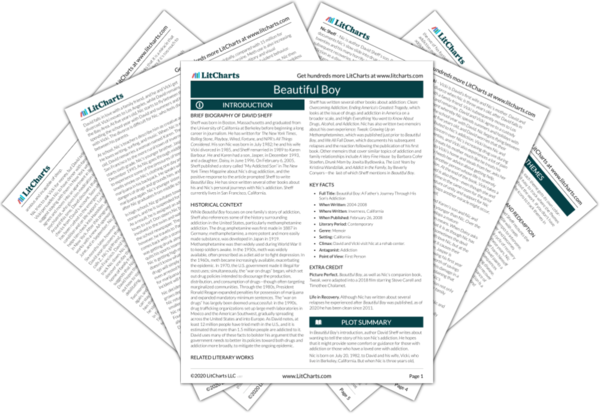Addiction, Ruin, and Redemption
In Beautiful Boy, author David Sheff recounts the true story of his son Nic’s battle with meth addiction. Despite David’s attempts to intervene, Nic becomes addicted to drugs as a teenager and becomes imperiled by that addiction as he undergoes a cycle of recovery and relapse in his early twenties. Throughout these years, Nic engages in increasingly dangerous behaviors that harm himself and also devastate his family. Through the book, David paints a…
read analysis of Addiction, Ruin, and RedemptionResponsibility and Blame
A central idea of Beautiful Boy is that of personal responsibility and blame. Author David Sheff relays the complicated and contradictory nature of searching for someone or something to blame for what has happened to his son, Nic, who is addicted to drugs. Despite multiple counselors telling David that he did not cause Nic’s addiction, David blames himself for the actions he did and didn’t take when Nic experimented with drugs as a teenager…
read analysis of Responsibility and BlameParenthood and Control
Beautiful Boy is largely an examination of parenthood when one’s child is in crisis. For David, being a parent is both “sublime and terrifying,” because children at once bring joy as well as “piercing vulnerability” to parents. Children develop with the guidance of their parents, yet they must also separate from their parents in order to find their own way as adults. David tries to ride that balance, wanting to guide Nic’s choices…
read analysis of Parenthood and Control
Support vs. Enabling
One of the most difficult aspects of Nic’s drug addiction is his insistence that he can handle it alone. Each time he relapses, he resists getting the help he needs from other people, asserting that he can control his disease. Yet eventually—usually following a life-threatening incident—Nic recognizes the fact that he needs help in order to treat his addiction. Even people like David, Nic’s father, require support to deal with their own frustration…
read analysis of Support vs. EnablingThe Disease Model, Stigma, and Treatment
In addition to recounting Nic’s personal struggle with addiction, his father, David, aims to educate readers on addiction generally. He provides scientific information on drugs and exactly how and why addiction is so harmful. He also examines the policies surrounding addiction that have exacerbated the issue nationally. In providing all of this information, David ultimately argues for the disease model of addiction, which holds that addiction has a biological basis and should be…
read analysis of The Disease Model, Stigma, and Treatment






